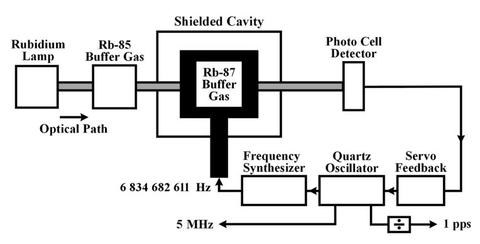Time and Frequency from A to Z, Re to Ru
The ability of a device or measurement to produce, repeatedly and without adjustments, the same value or result, given the same input conditions and operating in the same environment.
The degree to which a measurement can be determined. For example, if a time interval counter has a resolution of 10 ns, it can produce a reading of 3340 ns or 3350 ns, but not a reading of 3345 ns. This is because 10 ns is the smallest significant difference that the instrument can measure. Any finer measurement would require more resolution. The specification for an instrument usually lists the resolution of a single measurement, sometimes called the single shot resolution. It is often possible to improve upon the single shot resolution by averaging, but resolution can limit the uncertainty of a measurement.
The natural frequency of an oscillator. The resonance frequency is usually either divided or multiplied to produce the output frequency of the oscillator. The table below shows the resonance frequency for several types of oscillators. A high resonance frequency leads to a higher Q, and generally improves the stability.
| Oscillator Type | Resonance Frequency (Hz) |
|---|---|
| Pendulum | 1 |
| Quartz Wristwatch | 32 768 |
| Hydrogen Maser1 | 1 420 405 751.768 |
| Rubidium2 | 6 834 682 610.904 |
| Cesium3 | 9 192 631 770 |
1See Hellwig, Vessot, Levine, Zitzewitz, Allan, and Glaze, IEEE T. Instrum. Meas., IM-19(4), November 1970.
2The number for rubidium resonance (rounded to the millihertz) was obtained through measuremements comparing a cesium fountain to a rubidium fountain, and has been recommended by the BIPM as a secondary representation of the SI second. See Mandache, Vian, Rosenbusch, Marion, Laurent, Santarelli, Bize, Clairon, Luiten, Tobar, and Salomon, Proc. 2005 IEEE Intl. Freq. Cont. Symp., August 2005. Note that commercial rubidium standards can operate at resonance frequencies that differ from this value by a few hertz.
3The number for cesium resonance was first published in 1958 (Markowitz, Essen, Hall, and Parry, Phys. Rev. Lett., 1(3), 1958) and has been used since 1967 by the International System (SI) to define the second, the base unit of time interval.
The range of possible frequencies where a resonator can oscillate. Narrowing the resonance width of an oscillator leads to a higher Q, and generally improves the stability. For example, a resonator with a line width of 1 Hz will resonate only if it is within 1 Hz of the correct frequency.
The lowest priced members of the atomic oscillator family, rubidium oscillators operate near 6.83 GHz, the resonance frequency of the rubidium atom (87Rb), and use the rubidium frequency to control the frequency of a quartz oscillator. The optical beam from the rubidium lamp pumps the 87Rb buffer gas atoms into a particular energy state. Microwaves from the frequency synthesizer induce transitions to a different energy state. This increase the absorption of the optical beam by the 87Rb buffer gas. A photo cell detector measures how much of the beam is absorbed and its output is used to tune a quartz oscillator to a frequency that maximizes the amount of light absorption. The quartz oscillator is then locked to the resonance frequency of rubidium, and standard frequencies are derived from the quartz oscillator and provided as outputs as shown in the diagram.

Rubidium oscillators continue to become smaller and less expensive, and offer perhaps the best price to performance ratio of any oscillator. Their long-term stability is much better than that of a quartz oscillator and they are also smaller, more reliable, and less expensive than cesium oscillators.
The Q of a rubidium oscillator is about 107. Undesirable shifts in the resonance frequency are due mainly to collisions of the rubidium atoms with other gas molecules and aging effects in the lamp system. These shifts limit the long-term stability. Stability at 1 second is typically 1 × 10-11 and can be as small as 1 × 10-12 at one day. The frequency offset of a rubidium oscillator ranges from 5 × 10-10 to 5 × 10-12 after a warm-up period of a few minutes or hours, so they meet the accuracy requirements of most applications without adjustment.

